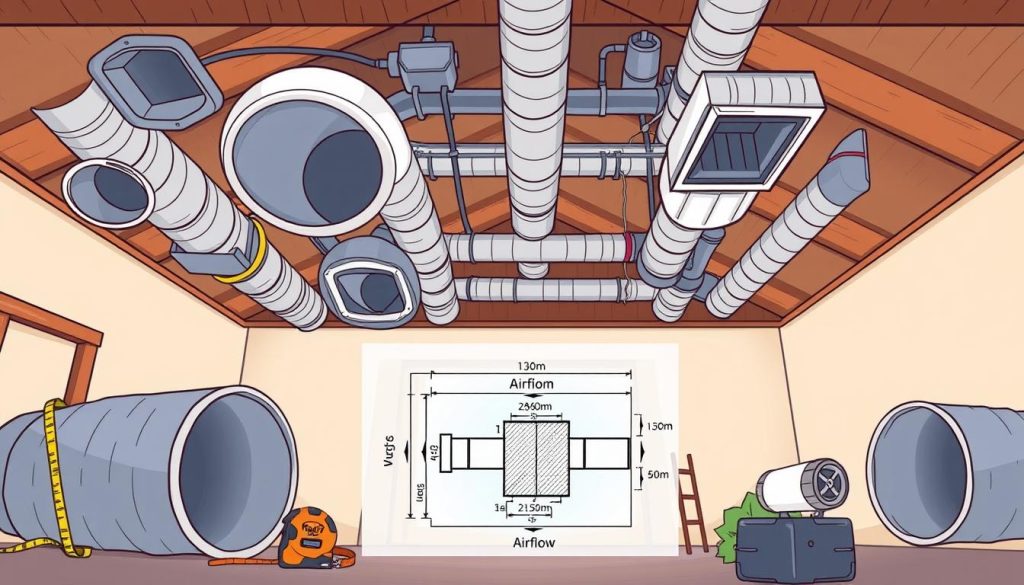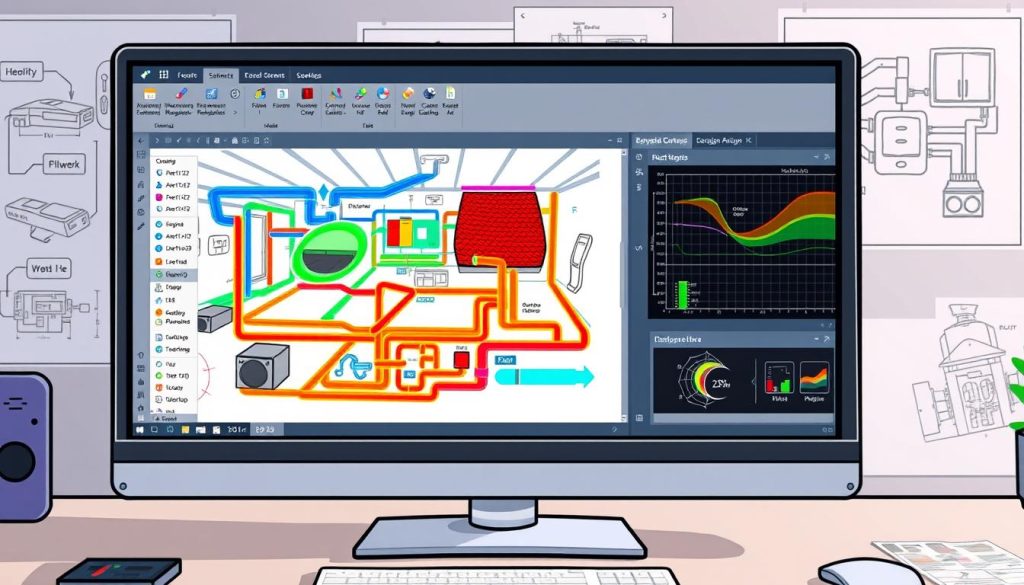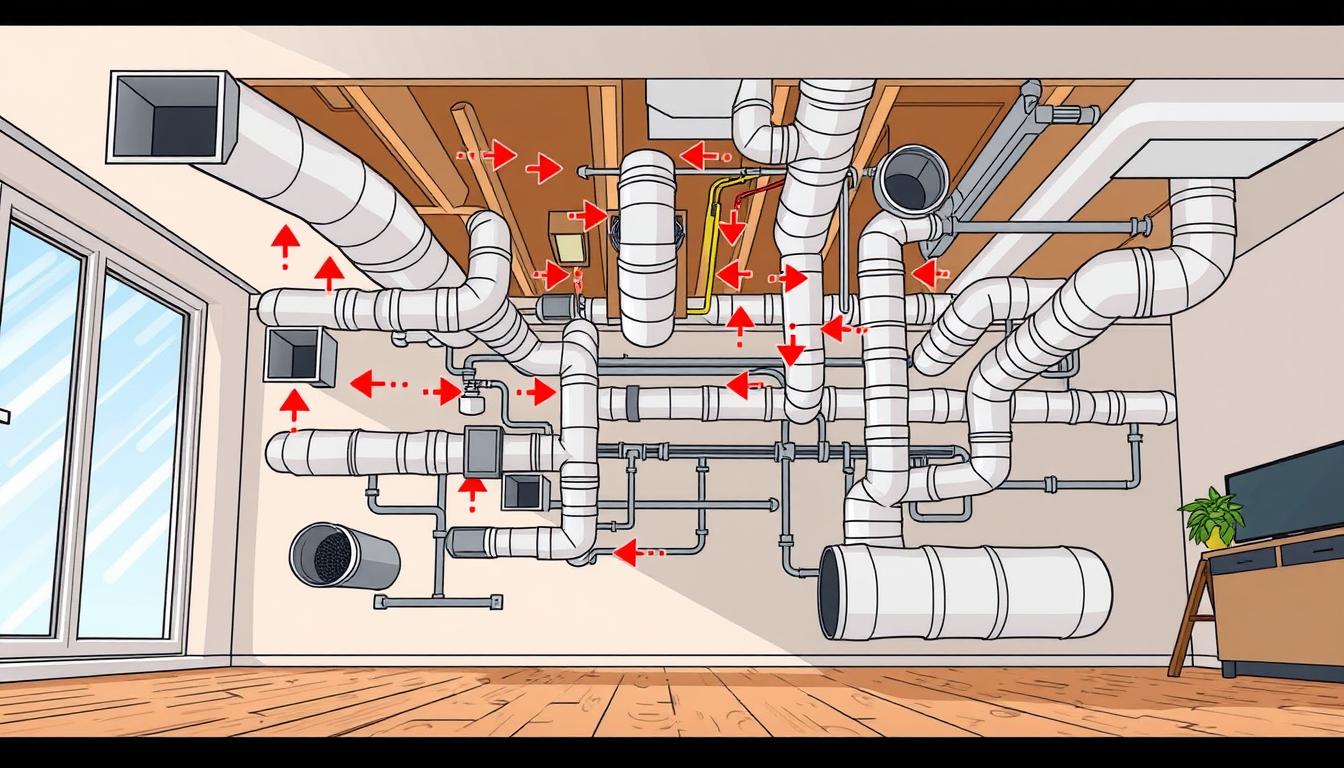To quickly check if a residential HVAC duct layout works well, follow a few steps. First, figure out how much air the system needs to move. Then, look at the size of the supply and return ducts. Also, think about the duct material and how much pressure it can handle.
By doing these things, you can spot problems and make sure your HVAC system works great. It will also save energy.
Key Takeaways
- Determine the target airflow based on the HVAC system’s tonnage capacity
- Assess the supply trunk and branch runout capacities to ensure they can handle the required airflow
- Evaluate the return duct sizing to maintain a balanced HVAC system
- Consider the impact of duct material and static pressure on overall system efficiency
- Utilize professional HVAC design software to optimize the duct layout and improve comfort
Determining the Target Airflow for the HVAC System
Understanding the target airflow is key when designing an efficient HVAC system for your home. The target airflow is based on the HVAC system’s capacity, measured in tons. Knowing how HVAC system capacity, airflow per ton, and HVAC load calculation work helps size your system right. This ensures your HVAC system delivers the right amount of conditioned air.
Calculating System Capacity Based on Tonnage
To find the HVAC system capacity in tons, divide your home’s total HVAC load by 12,000 BTUs per ton. The HVAC load calculation considers your home’s size, window count, insulation, and more. Accurate HVAC load calculation ensures your system meets your home’s heating and cooling needs.
Understanding Airflow Requirements per Ton
The target airflow for an HVAC system is about 400 CFM (cubic feet per minute) per ton of condenser capacity. For example, a 3-ton system should deliver around 1,200 CFM of airflow. But, if the designer suggests a higher airflow, use that instead. The average airflow in cooling mode is between 350-400 CFM per ton. Heating season airflow is about 65% of cooling airflow. Using 400 CFM per ton ensures enough airflow for both seasons.
| HVAC System Capacity (Tons) | Airflow Requirements (CFM) |
|---|---|
| 1 Ton | 400 CFM |
| 2 Tons | 800 CFM |
| 3 Tons | 1,200 CFM |
| 4 Tons | 1,600 CFM |
| 5 Tons | 2,000 CFM |
By understanding the relationship between HVAC system capacity, airflow per ton, and HVAC load calculation, you can ensure your home’s HVAC system is properly sized. This delivers the right amount of conditioned air for optimal comfort and energy efficiency.
Assessing Supply Trunk Capacity
To quickly check the HVAC supply trunk sizing in a home, look at the duct airflow capacity. This simple check can spot any airflow delivery problems.
First, list the diameters of all supply trunk start collars from the plenum. Then, use a duct sizing table to find out how much airflow each trunk can handle at a 0.1 friction rate. Add up the airflow capacity of all trunks. Make sure this total is more than the airflow needed for the system.
This quick check can show if the supply trunks are undersized and can’t deliver enough airflow. By doing this, you can find and fix duct layout problems early. This prevents comfort issues and keeps the HVAC system efficient.
How to Evaluate Supply Trunk Capacity?
- List the diameters of all the supply trunk start collars coming off the plenum.
- Refer to a duct sizing table to determine the airflow capacity of each trunk at a 0.1 friction rate.
- Add up the total airflow capacity of all the supply trunks.
- Ensure the combined capacity exceeds the target system airflow calculated earlier.
Why is Assessing Supply Trunk Capacity Important?
- It helps identify if the supply trunks are undersized and unable to deliver the required airflow.
- Addressing any duct layout issues proactively can improve HVAC efficiency and ensure proper comfort levels.
- This quick assessment provides valuable insights before the system is installed or operational.
By doing this simple check of the HVAC supply trunk sizing and duct airflow capacity, you learn a lot about the system’s design. You can spot areas for improvement. This helps make the residential HVAC installation more efficient and effective.
Examining Supply Branch Runout Sizing
Ensuring your home’s HVAC system works well is key. Proper HVAC supply branch duct sizing is essential. It involves looking at room-by-room airflow needs and using the right duct CFM calculation to size each supply branch runout.
Considering Room Loads and Equipment CFM
To size supply branch runouts, start by figuring out each room’s heating and cooling needs. Consider room size, window area, and airflow speed. Then, use these numbers to find out how much CFM each supply register needs.
Room CFM = (Room load/Whole house load) x Equipment CFM
Applying Duct CFM Calculation Formula
After figuring out each room’s CFM needs, use the duct CFM calculation formula to size the supply branch runouts. This formula considers duct length, bends, and register types. Proper sizing ensures your HVAC system works at its best, giving each room the right amount of air.
Evaluating Return Duct Sizing
Ensuring the right balance and static pressure in your HVAC system is key. Proper HVAC return duct sizing is as important as sizing the supply ducts. First, add up the airflow capacity of the return ducts. Then, compare it to the target system airflow.
Homeowners often face issues with oversized returns. For example, using a 16-inch duct on a 3.5-ton system can only handle about 1,050 CFM. This imbalance can cause problems like reduced efficiency, uneven cooling or heating, and higher energy costs.
Key Questions to Consider for HVAC Return Duct Sizing
- What is the total airflow capacity of your return ducts?
- How does this compare to the target airflow of your HVAC system?
- Are there any signs of oversized or undersized return ducts, such as excessive noise, uneven air distribution, or high energy bills?
- Have you considered the impact of duct material and layout on return air system performance?
- Have you consulted with a professional HVAC contractor to ensure your return ducts are properly sized and balanced?
By addressing these questions and ensuring your return air system assessment is accurate, you can improve your HVAC system’s efficiency and comfort. This leads to lower energy bills and a more comfortable living environment.
| HVAC System Capacity | Recommended Return Duct Size | Typical Return Airflow (CFM) |
|---|---|---|
| 2 ton | 12 inch | 600-800 CFM |
| 3 ton | 14 inch | 900-1200 CFM |
| 4 ton | 16 inch | 1200-1600 CFM |
| 5 ton | 18 inch | 1500-2000 CFM |

How do you quickly evaluate a residential HVAC duct layout?
Checking a residential HVAC duct layout is key for good system performance and comfort. By quickly looking at the duct system, you can spot common problems. You’ll also see how duct materials affect airflow.
Identifying Common Undersizing Issues
When checking a residential HVAC duct layout, look for undersizing issues. These can happen in a few main areas:
- Supply Trunk Capacity: If the trunk is too small, it limits airflow. This can cause uneven temperatures and lower efficiency.
- Supply Branch Runouts: If branch runouts are too small, they can’t deliver enough airflow to rooms. This leads to comfort problems.
- Return Ducts: If return ducts are too small, it can upset the system balance. This causes static pressure issues and less airflow.
Considering Impact of Duct Material Choice
The type of duct material used affects airflow and static pressure. Flexible ducts are easier to install but may resist airflow more than rigid metal ducts. It’s important to check the duct material’s impact on the residential HVAC duct layout assessment for better system performance.
By quickly checking for common duct sizing problems and duct material impact on airflow, you can spot issues early. This helps ensure the HVAC system works well. It delivers the best comfort and efficiency to homeowners.
Analyzing Static Pressure and Friction Rate
Understanding static pressure and friction rate is key when checking your HVAC duct layout’s efficiency. These factors ensure your duct system is the right size. It must deliver the needed airflow without overloading the system.
Calculating Available Static Pressure
Available static pressure (ASP) is what’s left after subtracting system component pressure drops from the total external static pressure. It shows how well the system can push air through resistance.
Determining Total Effective Length
The total effective length (TEL) of your duct system includes pressure drops from straight runs and fittings. Knowing this length is vital for figuring out the duct friction rate. This rate is crucial for sizing your ducts correctly.
To find the duct friction rate, use this formula: Friction Rate = (ASP x 100) / Total Effective Length (TEL). By knowing the static pressure budget and friction rate, you can size your HVAC duct system right. This ensures it delivers the needed airflow without overloading the system’s HVAC static pressure analysis capabilities.
| Metric | Description |
|---|---|
| Available Static Pressure (ASP) | The amount of static pressure remaining after subtracting the pressure drops of system components from the total external static pressure. |
| Total Effective Length (TEL) | The length of the duct system that accounts for pressure drops from fittings, turns, and other duct components, not just the straight duct runs. |
| Duct Friction Rate | Calculated as (ASP x 100) / TEL, this metric helps ensure proper duct friction rate and effective duct length for the duct system. |
Optimizing Duct Design Through Proper Sizing
Proper duct sizing is key for HVAC system performance. Undersized ducts lead to high static pressure and reduced airflow. This can cause equipment problems like premature wear. Oversized ducts can result in uneven temperatures and wasted energy.
Improving HVAC Efficiency and Comfort
Ensuring the duct system is the right size improves efficiency and comfort in the home. Experts say good airflow can tolerate some balance issues. But finding the perfect size is crucial for HVAC duct system optimization and duct sizing and efficiency.
To achieve this balance, HVAC pros must:
- Determine the right system capacity for the home’s size and needs
- Calculate the needed airflow per ton of equipment
- Size supply trunk, branches, and return ducts correctly
- Consider duct material and static pressure on efficiency
By focusing on these aspects, HVAC experts can optimize ductwork. This ensures the best performance and comfort for homeowners.
Utilizing Professional HVAC Design Software
Using HVAC design software can change the game when designing your home’s HVAC duct system. These tools make it easier to size and optimize your ductwork. This leads to better comfort and energy savings.
Some contractors use Wrightsoft or Elite Manual J/S/D for duct sizing. But, these programs might not always work well. Instead, try a free online duct system design tool like the ServiceTitan Ductulator. It helps figure out the right duct sizes based on room sizes and airflow needs.
Even with these tools, it’s key to talk to a licensed HVAC pro for the best results. They can make sure your duct system is designed just right for your home.
How do HVAC design software programs help with duct system sizing?
- Automate calculations for airflow, static pressure, and duct dimensions
- Incorporate real-time data on room sizes, equipment specifications, and airflow requirements
- Identify potential issues like undersized ducts or inefficient duct layouts
- Suggest optimized duct configurations to improve HVAC efficiency and comfort
What are the benefits of using an online duct sizing calculator?
- Simplifies the process of determining the right duct dimensions
- Considers factors like room loads and equipment CFM to size ducts accurately
- Provides quick, easy-to-understand guidance on duct design
- Helps homeowners and contractors identify potential issues early in the process
While digital tools are very helpful, don’t forget the importance of a skilled HVAC pro. They ensure your duct system is set up right. Their advice can help you get the most out of HVAC design software for better comfort and energy use at home.

Conclusion
Quickly checking a home’s HVAC duct layout is key to a comfy living space. It ensures your heating, ventilation, and air conditioning work well. You need to look at airflow, duct sizes, and pressure to make sure everything runs smoothly.
Online tools can help, but getting a pro’s help is essential. They know how to make your ductwork perfect for your home. They consider things like room size and the type of duct material used.
By following the right steps for HVAC duct layout evaluation, residential HVAC system optimization, and HVAC system design best practices, you get comfort and energy savings. The right design makes your home cozy and efficient. It’s all about making your home a comfortable place to live.





0 Comments